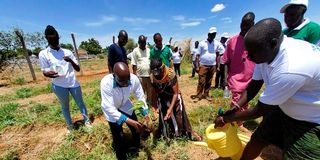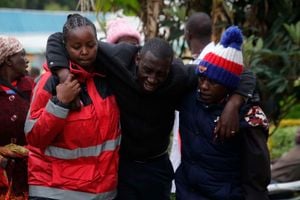From 'valley of death' to oasis: How tree planting projects are transforming Kerio Valley

Kerio Valley Development Authority Managing Director Samuel Naporos and community members plant trees at Kerio Valley escarpment.
What you need to know:
- Within two years, most of the degraded land had been reclaimed and the escarpment is now reclaiming its lost glory.
What started as a group effort to reclaim degraded community land due to deforestation has seen several hectares of Kerio Valley escarpment regenerated by planting more than 200,000 indigenous and fruit trees in the last two years.
The initiative of Kerio Valley Community Forest Association has attracted the attention of the Kenya Forest Service (KFS) and development partners like Kerio Valley Development Authority (KVDA), which have offered technical and management support to the group to promote afforestation programmes with an aim of combating the effects of climate change.
The Community Forest Associations (CFA) spread across the Kerio Valley belt in Elgeyo Marakwet County are involved in regenerating trees that thrive well in the area. They plant indigenous trees in escarpment areas to hold the soil and fruit seedlings in the lower areas as a source of revenue and food security.
"We embraced community laws to secure land degraded through unchecked agricultural practices and allowed the vegetation to regenerate before embarking on planting indigenous trees on the escarpment," said Mr James Kwambai, a group chairman from Muskut, Keiyo South.
To sustain a steady supply of tree seedlings, the CFAs established tree nurseries and trained their members on management and tree care.
"Within two years, most of the degraded land had been reclaimed and the escarpment is now reclaiming its lost glory," added Mr Kwambai.
He lauded KFS and KVDA for supplying the groups with tree seedlings and technical and managerial skills, especially in the cultivation of fruit trees.
Consequently, some pastoralists in the region have invested in banana cultivation and adapted modern technologies to increase production.
"We have new banana orchards that can remain in place for between five to seven years, and the yield can be 32 tonnes per hectare compared to conventional bananas, which give a yield of 14 tonnes per hectare," explained Ms Jane Kiptoo, a farmer and a group CFA member from Tot area.
She said Kerio Valley region is a high potential area for banana production due to soil fertility and plenty of water following the establishment of furrow irrigation.
Apart from being able to produce enough food for local consumption, Ms Kiptoo sells the rest of the bananas to markets in the North Rift region and generates enough income to support her family.
"It was difficult for agricultural experts to sell the farming idea in an area considered unsuitable for crop production," said William Kaino an agricultural expert in Tot division.
He explained that most of the locals were reluctant to diversify to agricultural production, which they considered to be tedious work compared to keeping livestock.
"We are now cultivating various crops and vegetables apart from rearing some animals for domestic purposes," said Ms Kiptoo.
Apart from banana cultivation, farmers in the region grow paw paw, mangoes and cassava under a furrow irrigation scheme shared among members of the Pokot, Turkana, and Marakwet pastoral communities.
Emphasis is on drip irrigation that has proved to be more efficient and economical.
However, Kerio Valley residents prefer furrow irrigation owing to plenty of water and rough geographical terrain.
To maintain a steady supply of water to support integrated food security programmes as well as water for domestic use, KVDA has allocated Sh550 million for sinking boreholes and constructing small dams in the region.
Residents have also embraced fodder production to ensure they are able to feed their livestock
throughout the year especially during dry spells, and reduce rampant cases of conflicts over grazing fields.
More than 4,000 households from the semi-arid counties of Turkana, Samburu, West Pokot, Baringo, and Elgeyo Marakwet will benefit from the water project.
"We will drill boreholes, install solar water pumps and build more storage facilities for animal fodder. This is aimed at ending conflict among pastoralist communities," KVDA Managing Director Sammy Naporos said.
He said the project will empower the counties to invest in small-scale irrigation projects to support crop production and food security.
"The water supply project is designed to deliver a quick response from our authority to counties to mitigate the destructive effects of drought and contain armed conflict among pastoral communities," explained Mr Naporos.
"In Elgeyo Marakwet County, the projects will be undertaken at a budget of Sh130 million and benefit close to 7,000 households and approximately 106,000 livestock within the targeted areas," said Mr Naporos.
So far, 18 boreholes, three water pans and four small dams have already been completed and are in use.
Phase two will comprise 34 boreholes, 13 water pans and four small dams distributed in the region.
The boreholes will support 3,050 households and 81,000 livestock while small dams will benefit 3,800 households and 25,000 livestock, according to Mr Naporos.





